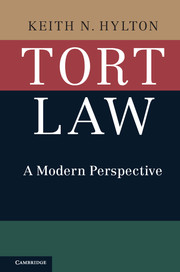Book contents
- Frontmatter
- Contents
- 1 Introduction
- 2 Policy and Tort Law
- 3 Evolution of Tort Law
- 4 Intentional Torts
- 5 Theoretical Foundations of Strict Liability
- 6 The Reasonable Person
- 7 Customs, Statutes, and the Reasonable Person
- 8 Inferring Negligence
- 9 Contributory Negligence and Assumption of Risk
- 10 Contributory Negligence, Comparative Negligence, and Incentives for Care
- 11 Joint and Several Liability, and Vicarious Liability
- 12 Factual Causation
- 13 Proximate Cause
- 14 Duty to Rescue and Special Relationships
- 15 Strict Liability: Conversion, Abnormally Dangerous Activities, and Nuisance
- 16 Defamation
- 17 Products Liability
- 18 Damages
- Index
1 - Introduction
Published online by Cambridge University Press: 05 June 2016
- Frontmatter
- Contents
- 1 Introduction
- 2 Policy and Tort Law
- 3 Evolution of Tort Law
- 4 Intentional Torts
- 5 Theoretical Foundations of Strict Liability
- 6 The Reasonable Person
- 7 Customs, Statutes, and the Reasonable Person
- 8 Inferring Negligence
- 9 Contributory Negligence and Assumption of Risk
- 10 Contributory Negligence, Comparative Negligence, and Incentives for Care
- 11 Joint and Several Liability, and Vicarious Liability
- 12 Factual Causation
- 13 Proximate Cause
- 14 Duty to Rescue and Special Relationships
- 15 Strict Liability: Conversion, Abnormally Dangerous Activities, and Nuisance
- 16 Defamation
- 17 Products Liability
- 18 Damages
- Index
Summary
The purpose of this book is to provide something that in my view has so far not been provided in the literature: a reasonably comprehensive, functionalist presentation of tort law that hews closely to doctrine. As I worked on the manuscript, I envisioned the final product serving as a textbook, mainly for law students. But I have also held onto the vision that it would provide a more thorough policy-grounded justification for the common law of torts than has been provided to date.
I use the word functional here as a less formal way of saying utilitarian. It conveys my immediate goals while helping me avoid being dragged into debates about the merits of utilitarianism as a theory of law. If you do not like utilitarianism, at least you should have some interest in understanding the functions of common law doctrines, or the effects these doctrines are likely to have on rational agents, or the manner in which they influence social interaction and its consequences. Another sense in which the word functional is useful to me is that it signals an interest in advancing a positive theory of the law rather than a normative theory. Positive theory seeks to understand, explain, and justify the legal doctrines that exist, rather than to design anew some area of the law, which is the aim of normative theory. Utilitarianism can provide a framework for redesigning the law, as Bentham demonstrated. But I have made few efforts toward this end in this book. I have criticized specific decisions, and specific portions of the case law, but on the whole the aim here is to explain and make sense of tort doctrine as it is. To that end, I offer a set of consistent policy perspectives that might enable one to better predict the outcomes of tort disputes.
Another way of describing this book is to compare it to paleontology. Studying individual cases is like studying parts of the skeleton of an animal buried in the ground for millennia. One can know the details of the skeleton's parts without having a sense of how the animal moved.
- Type
- Chapter
- Information
- Tort LawA Modern Perspective, pp. 1 - 9Publisher: Cambridge University PressPrint publication year: 2016



